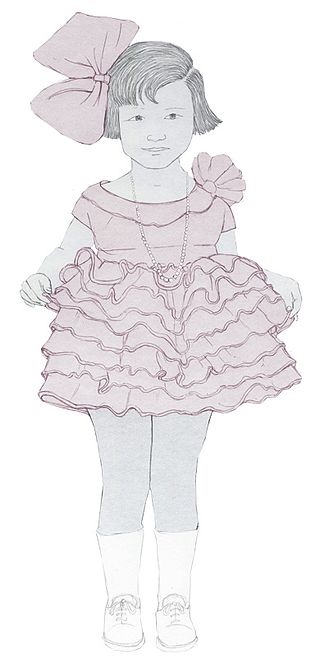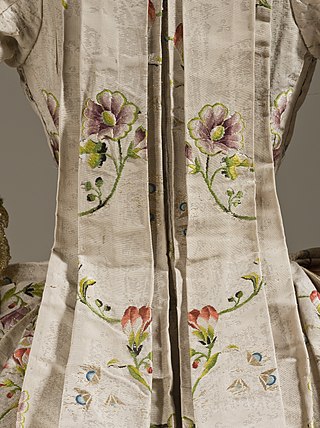Related Research Articles

Textile is an umbrella term that includes various fiber-based materials, including fibers, yarns, filaments, threads, different fabric types, etc. At first, the word "textiles" only referred to woven fabrics. However, weaving is not the only manufacturing method, and many other methods were later developed to form textile structures based on their intended use. Knitting and non-woven are other popular types of fabric manufacturing. In the contemporary world, textiles satisfy the material needs for versatile applications, from simple daily clothing to bulletproof jackets, spacesuits, and doctor's gowns.

Linen is a textile made from the fibers of the flax plant.

Muslin is a cotton fabric of plain weave. It is made in a wide range of weights from delicate sheers to coarse sheeting. It gets its name from the city of Mosul, Iraq, where it was first manufactured.

Buckram is a stiff cotton cloth with a plain, usually loose, weave, produced in various weights similar to muslin and other plain weave fabrics. For buckram, the fabric is soaked in a sizing agent such as wheat-starch paste, glue, or pyroxylin, then dried. When rewetted or warmed, it can be shaped to create durable firm fabric for book covers, hats, and elements of clothing.
Lawn cloth or lawn is a fine plain weave textile, made with fine combed cotton. Terms also used include batiste and nainsook. Originally the name applied to plain weave linen, and linen lawn is also called "handkerchief linen". The term lawn is also used in the textile industry to refer to a type of starched crisp finish given to a cloth product. The finish can be applied to a variety of fine fabrics, prints or plain.
Calendering of textiles is a finishing process used to smooth, coat, or thin a material. With textiles, fabric is passed between calender rollers at high temperatures and pressures. Calendering is used on fabrics such as moire to produce its watered effect and also on cambric and some types of sateens.
Dowlas was a strong coarse linen cloth of the 16th and 17th centuries, and initially, it was manufactured in Brittany. In the 18th century the fabric was also produced in England and Scotland. Dowlas was identical to sailcloth. The cloth was also imitated in cotton for the same use.
Zephyr or zephyr cloth is a sheer, lightweight cotton fabric, usually plain woven, used for dresses, blouses, and shirts. It may be striped or checked. It is named after Zephyr, the Greek god of the west wind.

Broadcloth is a dense, plain woven cloth, historically made of wool. The defining characteristic of broadcloth is not its finished width but the fact that it was woven much wider and then heavily milled in order to shrink it to the required width. The effect of the milling process is to draw the yarns much closer together than could be achieved in the loom and allow the individual fibres of the wool to bind together in a felting process, which results in a dense, blind face cloth with a stiff drape which is highly weather-resistant, hard wearing and capable of taking a cut edge without the need for being hemmed.

Organdy, also spelled Organdie, is a kind of fabric. It is a lightweight, balanced plain weave made of cotton with features of sheerness and crispness.

A bolt is a piece of cloth woven on a loom or created by a knitting machine, as it is processed, stored and/or marketed. Consequently, its dimensions are highly variable – flexible and dependent upon the manufacturing, machinery, quantity, size, thickness and quality of the product. It is a unit used in manufacturing, transport and inventory. It is also used as a descriptor for wallpaper, which uses different fabrication machinery. Being encompassing, it is by its nature a generic and ambiguous term of convenience and context, used to describe fabric and wallpaper.

Dornix, also known as dornicks and darnacle, is a wool and linen fabric, first used in the 16th century.

Sussi or susi is a term for multicolored striped or checked cloth produced mainly in Sindh. Sussi is thin handloom fabric made of cotton, silk, or a blend of the two, with colored warp stripes. Sindh region was known for its production and exports during the Mughal period. Sussi was most often made with red and blue, blue and white, or green and white stripes, but other patterns were also produced. The fabric was exported to England, where sousaes were in great demand in the 18th century.
Huckaback fabric or Huck is a type of toweling cloth with a bird's eye or honeycomb pattern. It is a loosely woven fabric made of cotton or linen with Huckaback weave.
Seerhand muslin (Seerhand) was a plain weave thin cotton fabric produced in the Indian subcontinent.
Bure was an old heavy woolen woven cloth that has undergone many changes since the Middle Ages. Hence, It was called with many names such as Bura, Burel, Burian, Burly, Burlesque, Burratto, Bournous, Burratine.
Diaper is a damask cloth with small geometrical patterns such as bird's eye or diamond shapes. Terms such as “bird’s eye” or “pheasant’s eye” refer to the size of the diamond in the design. Diaper has been used as a tablecloth.
Batavia, also known as Batavia silk and Levantine, was initially a silk fabric used for dresses in 18th-century France.

Faille is a type of cloth with flat ribs, often made in silk. It has a softer texture than grosgrain, with heavier and wider cords or ribs. Weft yarns are heavier than warp, and it is manufactured in plain weaving. It was especially popular in the 19th century.
A blend is a mixture of two or more fibers. In yarn spinning, different compositions, lengths, diameters, or colors may be combined to create a blend. Blended textiles are fabrics or yarns produced with a combination of two or more types of different fibers, or yarns to obtain desired traits and aesthetics. Blending is possible at various stages of textile manufacturing. The term, blend, refers to spun fibers or a fabric composed of such fibers. There are several synonymous terms: a combination yarn is made up of two strands of different fibers twisted together to form a ply; a mixture or mixed cloth refers to blended cloths in which different types of yarns are used in warp and weft sides.
References
- 1 2 Montgomery, Florence M. (1984). Textiles in America 1650-1870 : a dictionary based on original documents, prints and paintings, commercial records, American merchants' papers, shopkeepers' advertisements, and pattern books with original swatches of cloth. New York ; London: Norton. p. 348. ISBN 978-0-393-01703-8.
- 1 2 Fairchild's dictionary of textiles. New York: Fairchild Publications. 1959. p. 506.
- ↑ Denny, Grace Goldena (1962). Fabrics. Lippincott. p. 88.